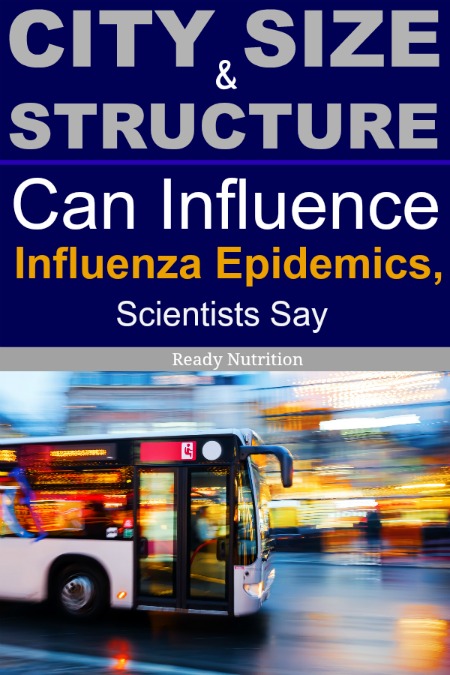
But just how does your city’s structure impact an epidemic?
Regardless of whether flu cases rise to a wintertime peak or plateau from fall to spring, new research suggests that the size of a city itself influences the contours of its flu season according to Science News. Larger cities with higher levels of crowding were associated with a steady accumulation of influenza cases throughout a flu season. Smaller cities with less crowding tended to have a flu season with a more intense surge in winter, researchers report in the October 5 publication.
“Understanding how the size and structure of cities impact disease spread may help us to predict and control epidemics,” study co-author and population biologist Benjamin Dalziel of Oregon State University in Corvallis, Oregon, said October 2 at a news conference.
In the United States, “flu season” occurs during fall and winter. The exact timing and duration of flu seasons can vary, but influenza activity often begins to increase in October. Flu activity typically peaks between December and February, but activity can last as late as May, according to the Centers for Disease Control and Prevention (CDC). –Ready Nutrition
 Flu cases generally peak during the winter in most areas of the United States because the air is quite a bit drier. That lack of humidity can help the flu virus to survive longer once sneezed or coughed out of an infected person, for example, allowing the virus to potentially infect more people. Dalziel his research team wondered how city size and structure fit into the mix, so they went about studying the implications.
Flu cases generally peak during the winter in most areas of the United States because the air is quite a bit drier. That lack of humidity can help the flu virus to survive longer once sneezed or coughed out of an infected person, for example, allowing the virus to potentially infect more people. Dalziel his research team wondered how city size and structure fit into the mix, so they went about studying the implications.
The team found that in large cities that have more crowding (that is, concentrated areas where people live and work) there appear to be more opportunities for the virus to find new hosts, even when the air conditions aren’t ideal for virus transmission. So the flu spreads steadily during the season; the virus doesn’t need to wait for winter’s dry air.
But in smaller cities with less crowding, the air conditions (rather than crowded spaces) seem to be the main driver of new cases, causing a spike in winter. Overall, the research team claimed that cities with high-intensity flu seasons, in which cases rise to a peak, tended to be in the eastern part of the country and had wider seasonal fluctuations in humidity levels.
However, scientists do admit that this idea that a city’s size can affect an epidemic needs to be looked into more. Infectious disease researcher Jeffrey Shaman of Columbia University said: “if we’re seeing these patterns, we have to figure out why.” Doing so could help researchers understand more about how flu is spread so that they “can do more to prevent its transmission.” Although there’s probably little anyone can do to prevent the spread of the flu, except protect themselves from it. No one else can boost your immune system for you and the flu vaccine has been shown to actually weaken your immune system’s antibody response in subsequent years.
While the Centers for Disease Control and Prevention (CDC) suggests getting the flawed vaccine to prevent the spread of the flu, it does also have a page that is dedicated to the numerous other ways people can avoid the flu called Preventing the Flu: Good Health Habits Can Help Stop Germs. Here, one can find useful common sense guidelines, like:
- Avoid close contact with people who are sick
- Stay home when you are sick
- Cover your mouth and nose
- Clean your hands
- Avoid touching your eyes, nose, or mouth
- Practice other good health habits
While “practice other good health habits” is wise advice, unfortunately, the CDC does not elaborate other than this blurb:
Get plenty of sleep, be physically active, manage your stress, drink plenty of fluids, and eat nutritious food.
The best, easiest, and the most obvious way to fight the flu before you get it is to boost your immune system, which can be done naturally. In the article titled: The Flu Fighting Arsenal: 5 Ways to Naturally Stop the Flu Dead In Its Tracks, Tess Pennington explains that “the best defense is a natural one.” The article will discuss how to boost your immune system and add some natural flu preventatives to your natural well-being arsenal. Eating a healthy diet (such as avoiding processed foods), drinking plenty of water, taking vitamins to supplement your diet, and getting plenty of good quality sleep can all help you stay healthy during cold and flu season.
While we may not be due for a flu pandemic, taking steps to minimize your chances of getting sick as opposed to relying on government agencies to save you afterward gives you a better fighting chance.
Symptoms of the flu generally include:
- Fever* or feeling feverish/chills
- Cough
- Sore throat
- Runny or stuffy nose
- Muscle or body aches
- Headaches
- Fatigue (tiredness)
- Some people may have vomiting and diarrhea, though this is more common in children than adults.
* It’s important to note that not everyone with flu will have a fever.
*This article is not meant to diagnose or treat any illnesses. It is meant for informational purposes only and should not be taken as medical advice.
Read More:
Are We Due for a Pandemic Flu? Here’s How to Prepare Just in Case
The Flu Fighting Arsenal: 5 Ways to Naturally Stop the Flu Dead In Its Tracks
The Prepper’s Blueprint: The Step-By-Step Guide To Help You Through Any Disaster
Is the CDC More Prepared for This Year’s Flu Season? And – Are You?

This article was originally published at Ready Nutrition™ on October 29th, 2018






